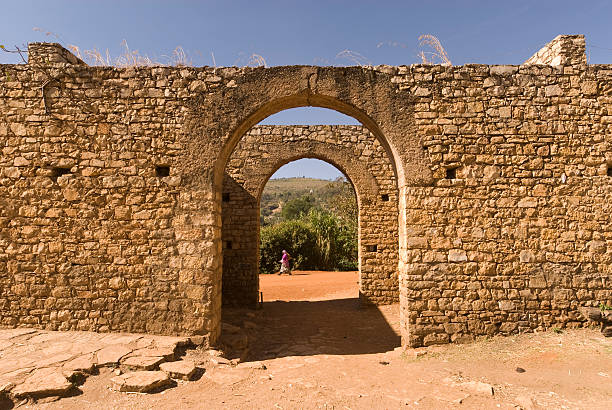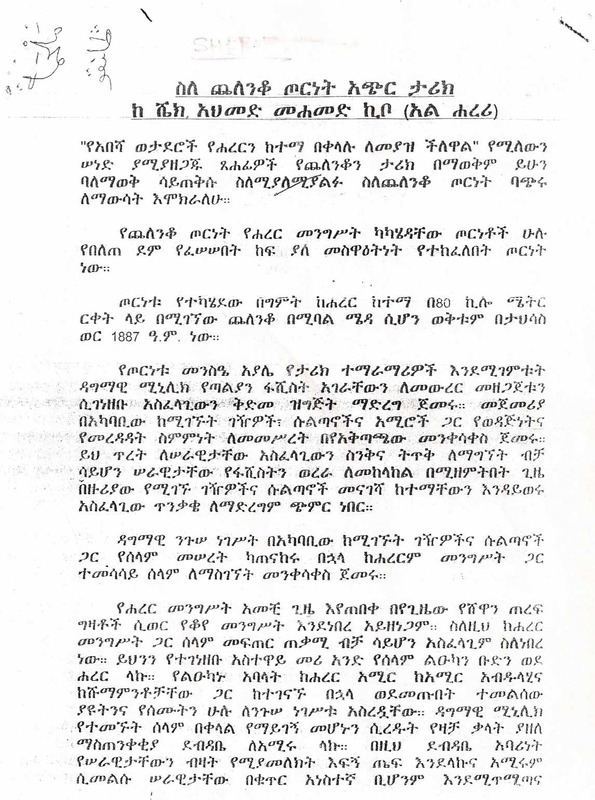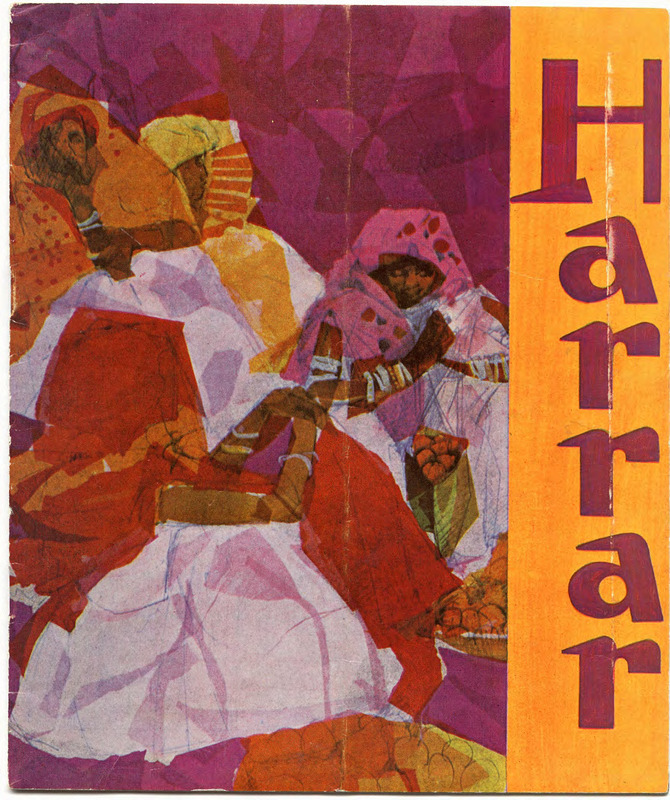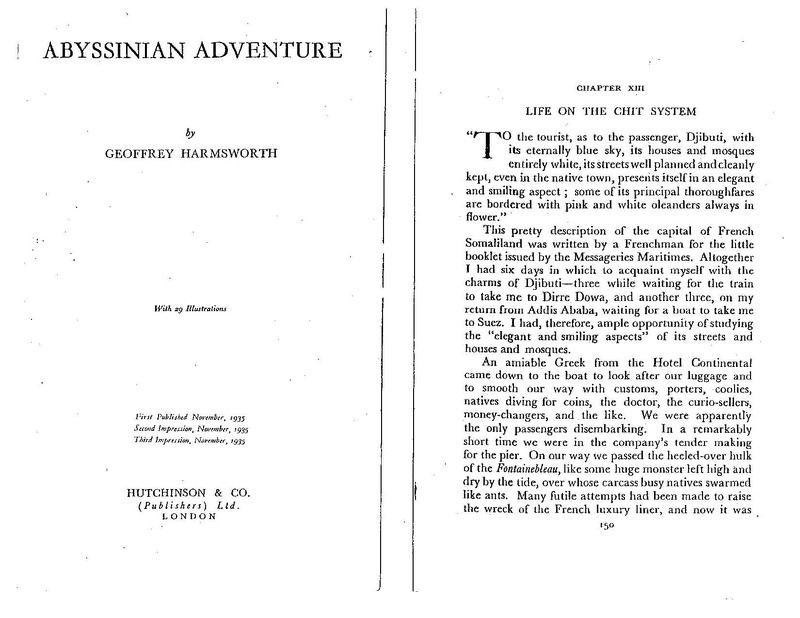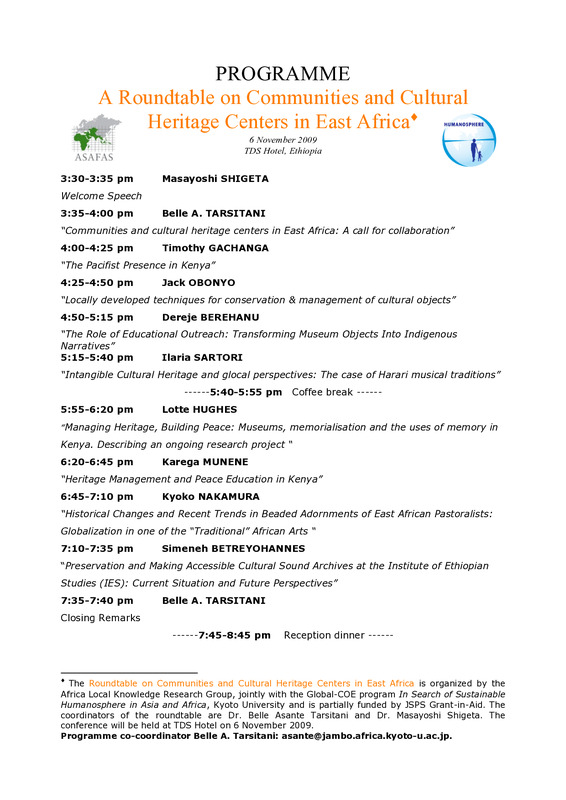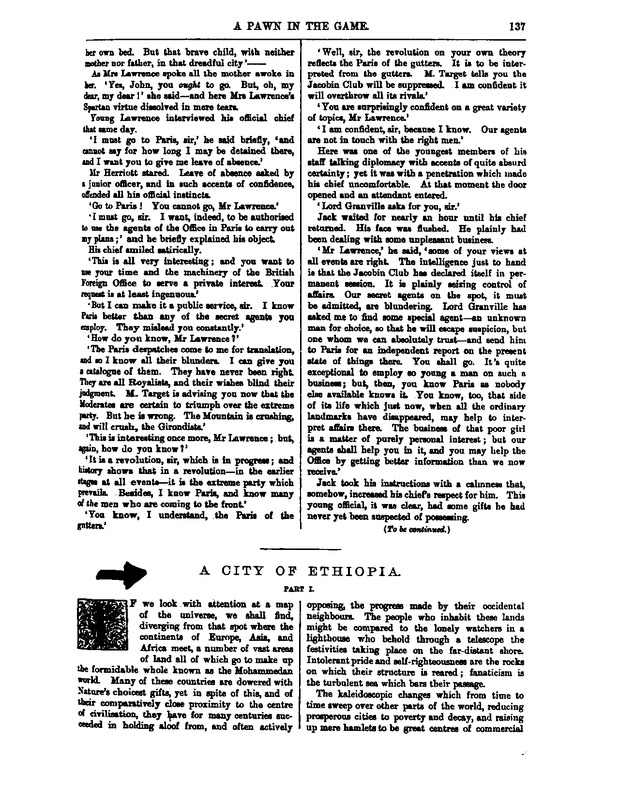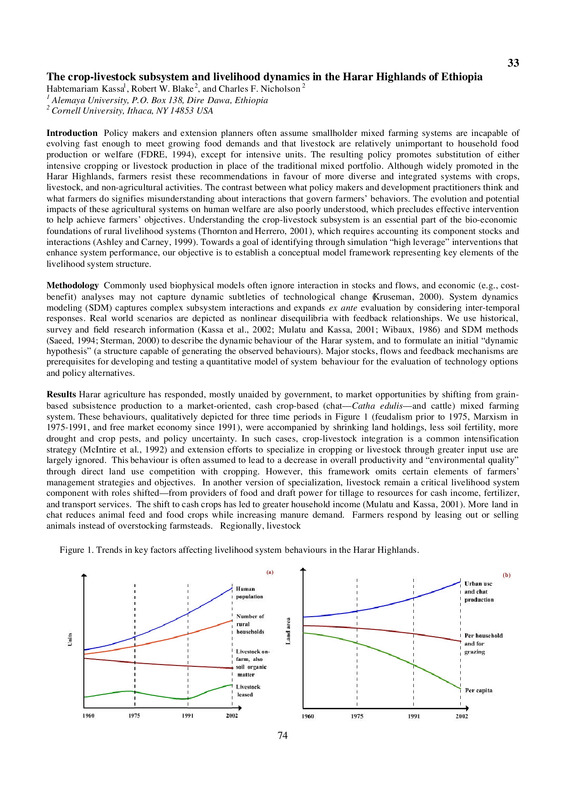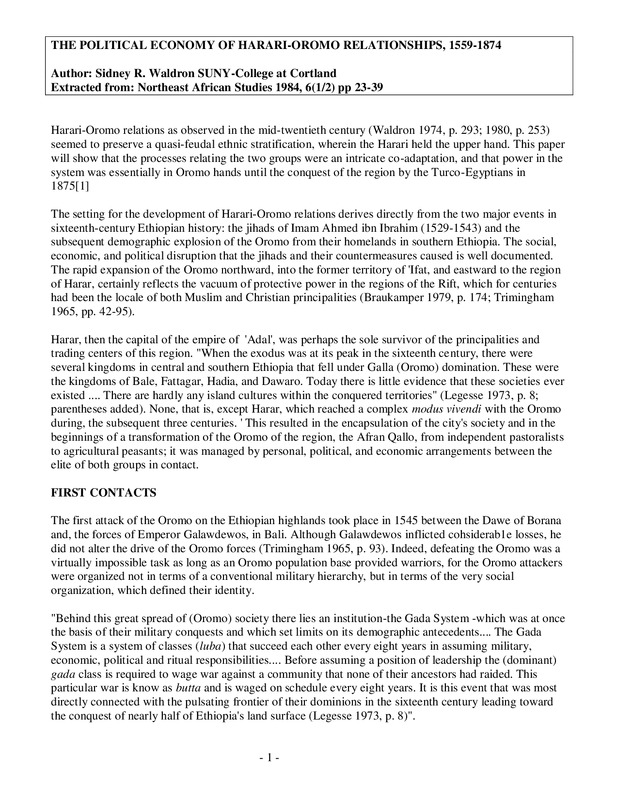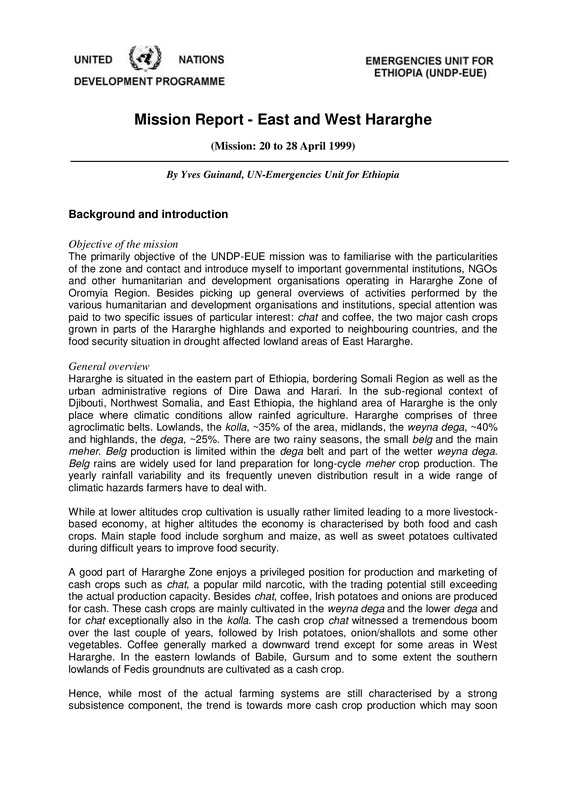Items
-
Harar home stay: living in a traditional AfricanDate: march 17,2011If you're staying for any length of time in a place, the best way to experience the local culture is through a home stay. Luckily Harar has a number of traditional homes offering spare rooms.A local guide showed me a few and I chose one hidden away in a small alley not far from the Catholic mission. This is the neighborhood that got Harar a UNESCO religious tolerance award because there's an Ethiopian Orthodox Church, a Catholic mission, and several mosques all within sight of each other. Walking home I use three minarets and a giant cross as landmarks.Harari homes look inward. All you see is a gate that leads to a compound of two or more houses, hidden behind their own gates. Enter the second gate and you're still not inside, you're in a courtyard with the bathroom to one side and to the other a large, ornately carved wooden door leading to the main building. Harari homes have a unique architecture. With thick stone walls and small windows, they stay cool even in the scorching heat of the day. Leaving your shoes at the front door, you enter the nedeba, or living room. The walls are covered in colorful plates and baskets and often cabinets with multicolored glassware. Hararis love to decorate their rooms with the products of their centuries-old crafts. People sit on a series of platforms, reclining against pillows. The platforms are painted red in memory of those who died at the battle of Tchellenqo in 1887, when the Ethiopian Emperor Menelik II defeated Harar's Emir Abdullahi and the city lost its independence.Where you sit depends on who you are. The amir nedeba is where the head of the family sits. It's on the highest platform, usually in one corner where he can see the entrance to the compound. In olden days there was a spot for keeping some spears right next to the amir nedeba, just in case the person entering the compound wasn't welcome. After a month in Harar I've only seen one guy who regularly carries a spear, though.
-
Chelenqo: The Untold StoryDate:The Authour presents the untold story of Chelenqo and it's aftermath. A narration of Hararies and a document content is manifested in the article. Criticism of the History depicted by Historical books is also reflected.
-
HararDate:Harar Harrar is these things, and Harrar is much, much more. The city is set high on the southern ridges of the Eastern Escarpment, overlooking the wild bush of valleys draining into Webi Shebeli country. Harrar is remarkable for climute alone, as its dry air, almost cont in uous sunshine, and pleasantly monotonous average temperature of 71.5 degrees F. lure the visitor with a sense of well-being unmatched elsewhere.
-
An assessment of the effectiveness of the upgrading and revitalizationDate: 2009The theses dissertation reports are dedicated in assessment of the effectiveness of the upgrading and revitalization intervention strategies in Harar city, which include, The Cultural Gentrification Approach in JAWCH, implementation of the Integrated Housing Development Program of the Federal Democratic Republic Of Ethiopia in Harar City, the contribution of the Redevelopment Of Private Investor Developers and Analysis Of The Housing Policy of the Harari National Regional State towards development of New In Situ Model of upgrading and revitalization strategies, to reduce slums, to combat slum formations and to alleviate worsening situations of slums and squatter settlements through housing condition improvements, specifically, and improvement of the site conditions, in general. Three areas are selected to conduct the whole dissertations, case study area one is the Jugel Ancient Walled City of Harar (JAWCH), from which demonstration of the effectiveness of the cultural gentrification approach in the locale is presented. Case study area two and three are outside the JAWCH from which the rest of the work, that are, in assessment of the effectiveness of the IHDP of the FDRE in Harar city; and redevelopment of the slum sites by private investors towards their contribution for housing improvements of the slum house holds, as well as for alleviation of increasing demand of housing as a result of urbanization, emigration and population growth in Harar city. Generally, the theses dissertations argue and evidence that all the above stated strategic approaches have their own contribution in reduction of the slum conditions. However, it is identified that they are not that much in prevention of new slum formation, which is a part of Millennium Development Goal 7, target 11 cities with out slum objective of UN‐Habitat, 2000.
-
Hararis and The 1974 Ethiopian Muslim RallyDate: 1974Interview with Hararis regarding the 1974 Muslim Rally held in Addis Ababa. Brother Dr. Ahmad Kelo, one of the leaders and organizers of the event, explains in detail the purpose and outcome.Brothers Mohmmaed Sherif,and Ibrahim Abdusalam also discuss the Historical and Political effects of the Rally on the entire situation of Ethiopia.
-
A Roundtable on Communities and Cultura Heritage Centers in East AfricaDate: 2009This presentation briefly introduces research into four museums in Harar, Ethiopia,highlighting the role that local actors played in the establishment, development andpatronage of these cultural heritage centers. Research into the traditional crafts,artisans and museums of Harar, found that recent conservation efforts resulted fromlocal initiatives and subsequent effective joint management of tangible heritage by acommunity working in conjunction with indigenous organizations, governmentadministrators and foreign interests. Without doubt, the local community’s efforts in thecontext of Harar’s museums exemplify the potential of indigenous resourcefulness increating opportunities for both preservation, and public presentation of folk customsand contemporary cultural practices.
-
A City of EthiopiaDate: 1908This article is an extract from the Chambers Journal of the 6th Series Volume XI 12-1907 to 11-1908 [Published in 1908] This article is both parts of the discussion about Harar.Submitted by a Friend of Harar and Ethiopia
-
The Harar Administration's Meeting to quell the Culub movementDate: 1948/ 1940 et.calThe Harari Administrations' Meetting to quel the Culub movement. The discussion and decision of the gathering is reflected in the Article. Names of participants including Prince mekonnen's views about the insurrection, and actions to be taken against the leaders of the movement , Information gathering , Introgation, imprisonment and subjugation of the Harari people to discourage them from such actions is presented. Language of Article is Amharic
-
Lines on the classification of Ethiopian-SemiticDate: 1996AbstractEthiopian-Semitic constitutes a compact, readily defined and homogeneous linguistic family, consisting of Ge' ez, Tigre, Tigrinya, Amharic, Argobba, Harari, Gafat, and the Gurage cluster. The most recent attempt to set up a classification of Ethiopian-Semitic was Hetzron [1972}, but this work was rather thoroughly criticized by Goldenberg [1977], and the field has yet to recover from it. The present note seeks to open the classification question anew by providing a basic, minimalist classification scheme, which can serve as a starting-off point for any future work on the subject. We begin with some of the results of Marcel Cohen [1931], "the father of Ethiopian studies" in the twentieth century. Cohen treats Tigre and Tigrinya as Northern Ethiopic, and Amharic, Harari, and the Gurage cluster as Southern Ethiopic. All are ultimately descendants of a ProtoEthiopic koine most closely resembling Ge'ez. Gurage, according to Cohen, is not a language or a linguistic unit in itself, but rather an ensemble of at least two separate and mutually unintelligible dialect clusters, Eastern Gurage and Western Gurage. Eastern Gurage consists of Wolane, Selti-Ulbarag, (and in the present state of our knowledge also Zway) , and is most closely connected with Harari. Western Gurage consists of several subgroups of dialects, in particular (a) Chaha, Ezha, Ennemor (Inor), Gumar, Gyeto (and in the present state of our knowledge Endegefi) and (b) Muher, Gogot, Masqan. Aymallel (Soddo, Kgstangiiiia), another Gurage tongue, is left unclassified by Cohen, as being perhaps intermediate between the two groups. Tentatively, he terms it North-Eastern Gurage. (Gafat and Argobba are not classified by Cohen.)
-
Notes on Haräla (Dire Dawa)Date: 2004A survey à vol d’oiseau Some 15 kms from Dire Dawa on the way to Dengego, Haräla is probably a XIII century town that sized nearly half sqkm. Walled, it was the capital of the Haräla3 kingdom located in between the Indian Ocean and the highlands of Ethiopia. It has developed for long time commercial links with Zeila, a sea town and a strategic door to the middle and far east. Through that, nilotic, high and low lands cultures of Ethiopia were easily intermingled with those from Arabia peninsula, other countries of Middle East, India and far East, as confirmed by chronicles of the time.
-
Preservation of Urban and ArchitecturalDate: 2010Preservation of Urban and Architectural Heritage of Harar, Ethiopia Hisham Mortada, Dept. of Architecture, King Abdul Aziz University, Jeddah, Saudi Arabia Abstract—The evolution of Harar, Ethiopia, goes back to the seventh century, when some Muslims from Mecca migrated to al-Habasha (Ethiopia) before Medina. These men spread Islam from Harar to various parts of the African Horn, thus Harar took a religious fame as the fourth holiest Muslim city. Since then, the city was developed by its Muslim population and became rich in its Islamic urban, architectural and cultural heritage. This has encouraged the UNESCO to declare this city as a World Heritage site. Regardless of the national and international efforts to preserve the Islamic heritage of Hara, the city is still suffering from physical decay. As a result a team from KAU took the responsibly of setting up a master plan aiming to preserve the urban and architectural heritage of Harar. As discussed in this research, the project consists of two phases. The first is an investigation of the potentials of preservation of urban and architectural heritage of Harar. This covers studies of historic, geographic, environmental, socio-cultural, urban and architectural aspects of the city. The second proposes a mechanism of dealing with the heritage of Harar through several stages such as a selection of an action area and surveying it in terms of land uses, building highest, buildings of special historic value, building physical conditions, and construction materials. The project is culminated in a detailed proposal for preservation and development of the action area in a sustainable sense. Prof. Hisham Mortada is also the author of a book titles Traditional Islamic principles of built environment. I find this book interesting in understanding how Islamic homes built and why, which reflects how Harari homes built as Islamic heritage city. I would encourage anyone to read the book. For anyone interested to comment on this book or research paper feel free to email it to [email protected] .
-
THE SPIRIT OF THE MILITARY HERITAGE PLACESDate: 2008The objective of this paper is to show the importanceand the necessity of the integrated preservation of the tangibleand intangible values of the military heritage places for thecontemporary and for the future generations. The method of thework consists in the attempt of the tangible and intangiblevalues definition of the military heritage places and in theanalyses of the different ways of their preservation. The resultsof analysis show the unbalance in the treating of the tangibleand intangible values of the military heritage places. Theconclusion presents the comparison between the conservationpolices and the practices concerning the preservation of thespirit of the military heritage places and the proposal for thenecessity of the increasing the interest in the integratedpreservation of the tangible and intangible values of the militaryheritage places.Ethiopia - Harar Jugol, the Fortified Historic Town (2006)
-
UNDP :Food Shortages Force Oromos of East Hararghe into MigrationDate: 1998In the town of Harar, a group of migrants from Fedis met in the main street gave a first impression on the nature of the problem. The people came to the town on foot because there was “no food at all” in their home areas of Fedis wereda, which is located south of the urban administrative region of Harari. If help was not forthcoming in Harar, the people indicated they would walk east on the main highway connecting Harar through Babile and Gursum to Jigjiga. Situation
-
The crop-livestock subsystem and livelihood dynamics in the Harar Highlands of EthiopiaDate:Introduction Policy makers and extension planners often assume smallholder mixed farming systems are incapable of evolving fast enough to meet growing food demands and that livestock are relatively unimportant to household food production or welfare (FDRE, 1994), except for intensive units. The resulting policy promotes substitution of either intensive cropping or livestock production in place of the traditional mixed portfolio. Although widely promoted in the Harar Highlands, farmers resist these recommendations in favour of more diverse and integrated systems with crops, livestock, and non-agricultural activities. The contrast between what policy makers and development practitioners think and what farmers do signifies misunderstanding about interactions that govern farmers’ behaviors. The evolution and potential impacts of these agricultural systems on human welfare are also poorly understood, which precludes effective intervention to help achieve farmers’ objectives. Understanding the crop-livestock subsystem is an essential part of the bio-economic foundations of rural livelihood systems (Thornton and Herrero, 2001), which requires accounting its component stocks and interactions (Ashley and Carney, 1999). Towards a goal of identifying through simulation “high leverage” interventions that enhance system performance, our objective is to establish a conceptual model framework representing key elements of the livelihood system structure.
-
From the ancient Jaliyei to the new gey fäqär. Relationships between traditional sung poetry and commercialDate: 2009The city-state of Harar, a micro-cultural island in Eastern Ethiopia, was for centuries a holy city of Islam and an international commercial crossroad. Local musical traditions (gey fäqär), unique and diverse at once, concurrently express the specific character of Harari identity as well as its openness to cultural exchange. The most ancient style of Harari traditional secular sung poetry is called ğāliyei (“my beloved”) and is performed polyphonically by two expert singers, the “thrower” and the “catcher” of a verse. Through the last decennia, young generations became acquainted with western melodic instruments and developed new musical forms: Harari modern songs, once practiced by local youth associations (mugād), today reached a certain commercial distribution. Despite formal and sociological differences, Harari “pop” is strictly interlocked with traditional gey fäqär: verses often correspond; themes openly describe, represent and celebrate Harari cultural identity; musical system is heptatonic and represents an exception to the widespread African pentatonism. Within Harari society, old and new cultural habits interact, balancing conservation and innovation. The analysis of Harari intangible heritage, from the ancient ğāliyei to the new commercial “pop” songs, discloses the main historical developments of this multifaceted musical culture.
-
The Political Economy of Harari-Oromo relationships. (1554-1975)Date: 1981Since the basic premise of this discussion is that ethnicity and ethnicrelations are variables which respond through time in accordance to a more basicpoTitical-economic infrastructure, it would be misleading of me to approach mytopic here as a study of how the Harari urban minority survived in the face ofthe overwhelming numberica l superiority of the surrounding Oromo. Rather I amconcerned with the forces and influences which shaped this relationship and—-perhaps more importantly—which shaped the experiences of these two neighboringpopulations of the southeastern periphery of the Ethiopian Empire.My earlier analyses of Harari-Oromo interrelationships were reasonablyadequate presentations of a system of ethnic stratification which I abstractedĞrduring fieldwork done from 1962-64 (Waldron. 1974:260-299; 1980:249-256). Their•purpose was to discuss the means by which the Harari townsmen had adhered tothei'" ethnic identity white engaging in daily contacts with other ethnic groups.Beyond that, my basic problem could be described as that of reporting thesocial morphology of Harari social institutions and their intricate influencesin ordering the daily life of the people of the city of Hara'r. At the timeof fieldwork, the Harari dominated the landholding in the region immediatelysurrounding the city. Two versions( published and unpublished ) of the article exist. Unpublihed form is with link.
-
US Ambassador Travels to Dire Dawa and Harar (12/02/10)Date: 2010In Harar, on Tuesday, November 30, the Ambassador took part in a ceremony marking the completion of the renovations of the historic Teferi Mekonnen Palace and made a donation of equipment to the ongoing effort to preserve and archive the important Islamic manuscript collection housed in the Palace (now called the Harar City Museum). The Teferi Mekonnen Palace renovation was funded through a $35,000 grant from the Ambassador's Fund for Cultural Preservation to Harar's Bureau of Culture and Tourism. The equipment provided by the U.S. Embassy to help preserve, display and archive the Islamic Manuscript collection is valued at approximately $27,000.
-
Mission Report - East and West HarargheDate: 1999The primarily objective of the UNDP-EUE mission was to familiarise with the particularities of the zone and contact and introduce myself to important governmental institutions, NGOs and other humanitarian and development organisations operating in Hararghe Zone of Oromyia Region. Besides picking up general overviews of activities performed by the various humanitarian and development organisations and institutions, special attention was paid to two specific issues of particular interest: chat and coffee, the two major cash crops grown in parts of the Hararghe highlands and exported to neighbouring countries, and the food security situation in drought affected lowland areas of East Hararghe. General overview Hararghe is situated in the eastern part of Ethiopia, bordering Somali Region as well as the urban administrative regions of Dire Dawa and Harari. In the sub-regional context of Djibouti, Northwest Somalia, and East Ethiopia, the highland area of Hararghe is the only place where climatic conditions allow rainfed agriculture. Hararghe comprises of three agroclimatic belts. Lowlands, the kolla, ~35% of the area, midlands, the weyna dega, ~40% and highlands, the dega, ~25%. There are two rainy seasons, the small belg and the main meher. Belg production is limited within the dega belt and part of the wetter weyna dega. Belg rains are widely used for land preparation for long-cycle meher crop production. The yearly rainfall variability and its frequently uneven distribution result in a wide range of climatic hazards farmers have to deal with. While at lower altitudes crop cultivation is usually rather limited leading to a more livestockbased economy, at higher altitudes the economy is characterised by both food and cash crops. Main staple food include sorghum and maize, as well as sweet potatoes cultivated during difficult years to improve food security. A good part of Hararghe Zone enjoys a privileged position for production and marketing of cash crops such as chat, a popular mild narcotic, with the trading potential still exceeding the actual production capacity. Besides chat, coffee, Irish potatoes and onions are produced for cash. These cash crops are mainly cultivated in the weyna dega and the lower dega and for chat exceptionally also in the kolla. The cash crop chat witnessed a tremendous boom over the last couple of years, followed by Irish potatoes, onion/shallots and some other vegetables. Coffee generally marked a downward trend except for some areas in West Hararghe. In the eastern lowlands of Babile, Gursum and to some extent the southern lowlands of Fedis groundnuts are cultivated as a cash crop. Hence, while most of the actual farming systems are still characterised by a strong subsistence component, the trend is towards more cash crop production which may soon Hararghe Mission: April 1999 2 bring the majority of Hararghe farmers to the cross-roads between subsistence and cash economy. The vast majority of the rural population is living from agriculture, with some pastoralists and agropastoralists in the lowlands. Increasing population density coupled with the lack of alternative employment opportunities leads to progressive land pressure and subsequent shrinking of individual landholdings or migration and utilisation of marginal lowland areas for agriculture. Climatic hazards are increasingly frequent, with pest infestations and crop diseases additionally hampering crop production. Coupled with high land pressure, the margin for farmers’ agroeconomic decisions is progressively narrowing. The shift to an increased and intensified chat production is one of the farmers’ response to face some of the constraints. But those areas, especially the lowland pastoralist and agropastoralist areas, where agricultural substitutes such as chat cannot make up for prevailing constraints, are increasingly suffering from food insecurity.
-
ETHIOPIA: ARCHAEOLOGISTS DISCOVER THREE MEDIEVAL TOWNSDate: 2007ETHIOPIA: ARCHAEOLOGISTS DISCOVER THREE MEDIEVAL TOWNSStaff Report PARIS, 7 APRIL 2007 - The ruins of three medieval towns were discovered last January in Ethiopia during the Gendebelo/Nora I exploratory mission coordinated by the French Center for Ethiopian Studies in Addis Ababa, directed by Francois-Xavier Fauvelle, a researcher at France's prestigious multi-disciplinary National Centre for Scientific Research (CNRS). These towns are probably the first material vestiges of the Shoa (or Shewa) kingdom, an important Muslim kingdom known from texts to have dominated the region from the 10th to the 16th century. Until now its precise place on the map has never been clear. The kingdom controlled one of the most important trade routes of the time, between the Christianized Ethiopian highlands and the Muslim ports of the Red Sea and the Gulf of Aden. Perched up at about 1300 meters, on the escarpment of the Rift Valley in an area now covered in thick brush and scrub, the remains of mosques, residential areas and city walls, and buildings with walls several meters high stud the sites of the medieval towns of Asbari, Masal and Nora. The population of the region is composed of mainly Muslim rural mixed farming communities, who dispute their rights to this area. The areas around these ancient sites show traces of terraced farming, but today they are pastures.
-
The Mennera Institute (Local NGO)- Harar Cultural and Heritage Center, Jugol Harar, EthiopiaDate: 2008The Mennera Institute (Local NGO)- Harar Cultural and Heritage Center, Jugol Harar, Ethiopia This model-project provides a framework of actions aimed towards the revival of Jugol, a UNESCO world heritage site. It involves the restoration of several key buildings of a distinctly Ethiopian style of architecture, creating a knowledge center for the promotion of traditional culture, social cohesion and religious tolerance, the creation of a center for the production of traditional handicrafts as well as the creation of a learning eco-tourism guesthouse, which would provide for the sustainability of the center.
-
Symbiotic and phenotypic characterization of rhizobium ...Date: 2007A total of 50 rhizobial isolates of field pea (pisum sativum) were collected from central Shewa, Gojam, Gondar, Wollo, Tigray, Arisi, Bale, Harar and Walayta. The rhizobia were isolated in culture and characterized using cultural, colony morphology and physiological characteristics. All isolates except three, changed bromothymole blue indicator to yellow indicating they are acid producers and fast growing and 84% of the isolates were fast growing and 16% were slow growing. The isolates showed diverse characteristics in their carbohydrate utilization, intrinsic antibiotic and heavy metal resistance. Most isolates from Harar and Arisi-Bale were found to be more tolerant to higher NaC1 concentration, pH (4.5 and greater than or equal to 9) and temperature (5 and greater than or equal to 38 C deg) extremes than others. Dendrogram obtained through cluster analysis using NT-STS version 2.1 in 62 phenotypic characteristics showed that isolates can be grouped into different clusters and groups. The relative symbiotic effectiveness of the isolates was determined in sand culture and analysis of plant dry matter, nodule number and total nitrogen uptake data using SPSS 11.5 at p=0.05 showed a significant difference among isolates. The highest dry matter of 3.35 g/plt was accumulated by each of the inoculant isolates of NSRIFP1 (Shewa) and NSR1FP5 (Gojjam) that were significantly different from the N-fertilized control, followed by NSR1FP2 and NSR1FP4 (Gojjam) that accumulated 2.91 g/plt and 2.60 g/plt, respectively. The percentage of total nitrogen (TN) per plants were ranging from 1.19 for isolate NSR1FP28 (Arisi-Bale), being the lowest, to 2.93 for each of isolates NSR1FP1 (Shewa) and 2 (Gojjam), being the highest. Most isolates from Tigray (86%), Shewa (80%), Gojjam (71%) and 67% of Gondar-Wollo were effective and very effective whereas, higher percentage of lowly effective and ineffective isolates were found from Harar and Arisi-Bale. The most effective isolates were NSR1FP 1 (Shewa) and 5 (Gojjam) with 133% dry matter accumulation relative to N- fertilized control and total nitrogen percentage (TN) of 2.93 and 2.88. The least effective isolate was NSR1FP47 (Harar) with 23% dry matter accumulation and 1.55 TN. In general, isolates were very diverse in many of laboratory and greenhouse tests. Hence, for better understanding of isolates to their interaction with host plant, further physiological, molecular and field studies are recommended.
-
Crop Production Zones in EthiopiaDate: 2004Cash CropsCoffee and chat are Ethiopia’s major cash crops, with coffee cultivation in direct competition with chat, the second major agricultural export. Chat is a mild stimulant harvested from a shrub (Catha edulis), the fresh leaves of which are chewed, and popular in the arid regions of Ethiopia, Kenya, Djibouti, and Somalia. Domestically, chat is a major source of revenue in the southeastern areas of Ethiopia, with the bulk of the crop being ferried daily by air and truck to Djibouti and Somaliland via Harar and Dire Dawa. For farmers it offers far quicker returns on investment than coffee, although much of the sale price accrues to the merchants and distributors.
-
THE MINERAL INDUSTRIES OFDate: 2002Stone, Dimension.—Basalt and scoria were used in road construction. National Mining Corp. (NMC) (a subsidiary of Midroc Ethiopia) mined and polished calcitic marble from the Dalleti area in western Ethiopia. Saba Stones produced calcitic marble in Tigre. Ethiopian Marble Industry (EMI) mined marble at Harar in eastern Ethiopia and at various sites in the western part of the country. EMI processed its raw materials in Addis Ababa. Deposits of pumice occurred at the Gari Baldi Pass and at Kimbibit in the Rift Valley; pumice was used in domestic cement production. NMC produced amphibolite, granite, and limestone. Ethiopia had a total of at least 34 deposits of dimension stone, with 10 operating quarries, and 4 processing plants (Mengistu and Fentaw, 2000; Mining Journal, 2002).
-
From Barara to the IndiesDate: 2010An historical and archaeological interpretation of the Extended East Route for cultural tourism, stretching across East Ethiopia, Somaliland and Djibouti.This brief study is composed of an introduction and a proposal to carry out a wide research in Ethiopian and North Somali medieval history, through a set of archaeological campaigns to understand better a minimally known period of great value. The proposal is centred on relationships to a new touristic route, applying action research methods. So that every finding means a new resource along the route and can become a revenue opportunity. Prof. Ahimed Zacariah, the noted Harari scholar, has been involved in excavations in the Harla sites between Harar and Dire Dawa. A team has recovered there in 1987 a coin supposed to be Chinese, and older than that recently unearthed in Mambrui, Kenya. It is the best proof so far of how far fledged the trades were. His job should be reinforced, to also better understand the Harla’s role in the trade chains.Koremi, a significant medieval site near Harar has never been appropriately dated. The Kundudo massif and its underlying valleys still hide Hubat, the fief and supposed birthplace of Mohamed al Ibrahimi, the conqueror of Abyssinia, and more towns. Seven in all affirms Cherif, the museum curator in Harar. One name I recall, Samti Guey. There should be six more. Beyond Babile, in one of the valleys of the present day Elephant Sanctuary was Bia Woraba, atown found and described by Phillips Paulitschke in the late nineteen hundreds as characterised by tall orderly stone walls. Meftuh Shash from Gursum and Toronto has only weeks ago seen there, also from Google earth imagery structures definitely worth a survey and consequent excavations.

